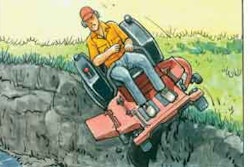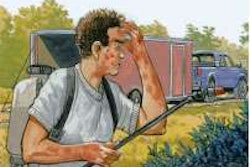
Protect yourself from heat-related illness
The accident: A 30-year-old landscaper is mowing a residential lawn when he collapses at the end of the day. His co-worker reports he complained of feeling light-headed and short of breath a few hours before he collapsed and refused offers of water. Paramedics transported the man to the hospital, where he dies shortly after arrival. A body temperature of 107.6 degrees Fahrenheit is recorded.
The bottom line: According to the CDC, heat-related deaths are some of the deadliest weather-related health issues in the United States. Outdoor workers like landscapers are particularly at risk. Working outside increases your chances of suffering heat-related illnesses such as heat cramps, heat exhaustion, and, the most life-threatening, heat stroke. In the example case, temperatures were only in the upper 80s, but the humidity was high and it was early in the season. The worker had been doing heavy labor including mowing, weeding, and digging throughout the day without stopping to rest. He had access to water, but as he became more disoriented and agitated, he refused to hydrate.
The man showed signs of heat exhaustion early on when he was sweating heavily, then became pale, clammy, and weak. By the time he progressed to heat stroke, his skin was hot and dry, he had a rapid pulse and was stumbling before he fell unconscious.
Heat stress can put not just your health at risk, but can endanger others around you as it may impair your ability to operate equipment safely. Some severe heat stress symptoms include sweaty hands, blurred vision, headache, dizziness, nausea, loss of dexterity, decreased reaction time, lapses in judgment, and irritability.
Tips for protecting yourself from heat stress:
• Acclimate slowly: It generally takes five days of working at least 1½ hours per day for the body to become acclimated. Check weather forecasts for heatwave information.
• Dress for summer. Lightweight, light-colored clothing reflects heat and sunlight and helps your body maintain normal temperatures. Long sleeves and pants are still necessary to protect your body from flying debris and other safety hazards.
• Wear a hat or sun visor.
• Eat small meals and salty snacks throughout the day.
• Drink plenty of water or other non-alcoholic, non-caffeinated fluids. Your body needs fluids to keep cool, and you should drink them even if you don’t feel thirsty. Drink one pint of water every 15 to 20 minutes in extreme heat. Urine should be clear. If it’s dark, you are probably dehydrated.
• Do not take salt tablets unless specified by a physician.
• Take frequent breaks in shaded or air-conditioned areas.
• Use the buddy system to keep an eye on your co-workers.
• Some medications can make you more susceptible to heat illnesses. Check with your doctor or pharmacist to find out if any medicine you are taking could affect you while working in the heat.
• Do the heaviest work during the coolest part of the day. This is usually between 6 a.m. and 10 a.m.











